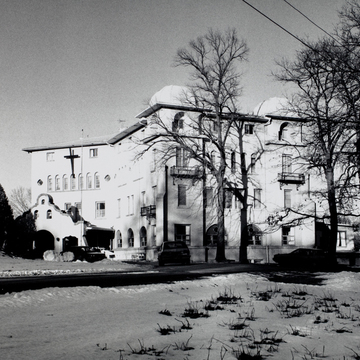You are here
Hotel Carlsbad (Family Life Center)
Though referred to at the time and after as an example of the “Moorish design,” the Hotel Carlsbad is in fact Iowa's most luxurious example of California's Mission Revival. From the beginning of the 1900s on through the mid-teens, the image of California's missions spread all across the country. Considered exotic (by Anglos) and associated with California as a place of perpetual play, the style came to be used often for recreation buildings, amusement parks, and resort hotels.
The architect who through remodeling gave the older Carlsbad Hotel building its Mission Revival appearance around 1911 was obviously aware of many California examples, particularly Arthur B. Benton's famous and widely illustrated hotel, the Mission Inn at Riverside. The design also reflects the state buildings constructed by California at the 1893 World's Columbian Exposition in Chicago and at the later expositions held at Buffalo and Saint Louis. The three-story stucco hotel with a red tile roof has a freestanding entrance screen almost identical to that of the Mission Inn in California. The paired towers, parapeted gable ends, and rows of arched windows are hallmarks of the style, whether in Iowa or California. At the beginning of the Great Depression in the 1930s the hotel was forced to close. It was later used as a hospital, and more recently as the Family Life Center, a church-related institution.
Writing Credits
If SAH Archipedia has been useful to you, please consider supporting it.
SAH Archipedia tells the story of the United States through its buildings, landscapes, and cities. This freely available resource empowers the public with authoritative knowledge that deepens their understanding and appreciation of the built environment. But the Society of Architectural Historians, which created SAH Archipedia with University of Virginia Press, needs your support to maintain the high-caliber research, writing, photography, cartography, editing, design, and programming that make SAH Archipedia a trusted online resource available to all who value the history of place, heritage tourism, and learning.





